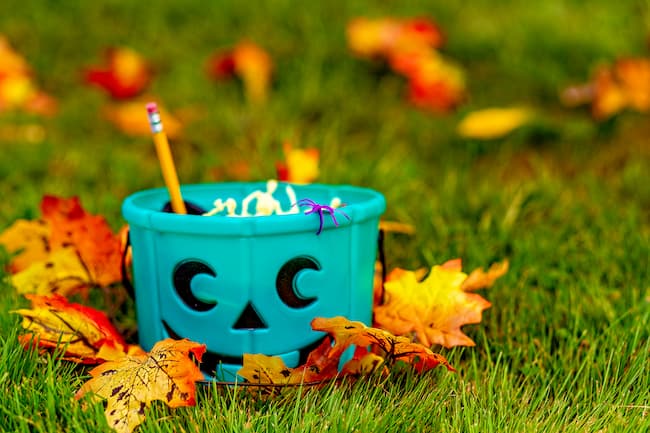Safe and Sound, an injury prevention service of Children’s Hospital at Erlanger and Safe Kids Southeast Tennessee, reminds parents that Halloween can be a fun night for children and adults if you follow important safety tips.
There is really nothing tricky to ensuring a safe night for your child on Halloween. By following these simple suggestions and using common safety sense, we know you will make it a memorable holiday for your family! Sometimes a few simple reminders will go a long way to prevent a scary situation: be safe, be smart, be seen.
Halloween safety: Costumes
- Be seen. Pick out a bright colorful costume so your child can easily be seen. Use reflective tape, flashlights, or glow sticks to make them more visible at night.
- Correct sizing. When choosing a costume, make sure it is the correct size for your child. Children should be able to walk without any obstruction from long costumes or props and see clearly through their masks.
- Don’t obstruct vision. Parents can show their creative side with face paint instead of allowing their child to wear a mask that covers the eyes.
- Safe props and costumes. Props should also have smooth or flexible edges to prevent injury if your child falls. Another safety feature to consider is to find a label on the costume that states it is flame retardant material to prevent fire or burning from candles or other fire items.
Halloween safety: Safety
- Keep an eye on your child. While at an event or if you are trick or treating with a group of people, never take your eyes off your child. Even though a church, neighborhood or community center event could seem less dangerous, remember there are other people you may not know attending the event.
- Stay together and stay in touch. Children under 12 should not trick or treat alone without adult supervision. Being with your child at all times is the safest action you can take but, regardless of age, it is helpful to have your child carry a cell phone with programmed phone numbers (if he or she is old enough to operate one) in case you get separated. Have older children check in regularly.
- Help your child stand out. By adding extra accessories to a popular costume or creating a costume that is different from all the others, you would certainly make it easier to spot your child.
- Take precautions to prevent illness. With cases of RSV during flu season in an on-going outbreak of COVID-19, the CDC recommends everyone wear a cloth mask, stay at least 6 feet away from others who do not live with you both indoors and outdoors, and wash your hands or use hand sanitizer frequently.
Halloween safety: Use or notice coded bucket colors
In recent years, a couple of new colors of buckets have been added to the traditional orange jack-o-lantern buckets including teal and blue. Teal buckets are used by some of the one in 13 children with severe food allergies, intolerances and other conditions; this signal allows them to take part in the Halloween festivities! If your child has these issues, consider getting them a teal bucket. If you will be inviting trick-or-treaters to your doorstep, have some non-food items on hand for these children such as pencils, small toys, bubbles, glow sticks, balls, slinkies, or noisemakers.
Keep your eyes peeled for dark blue buckets which children and young adults with autism may carry. If you see a child with this bucket, they may be non-verbal (and won’t say “trick-or-treat”) or may not meet your gaze or smile. This keeps parents from having to explain their child’s non-verbal communication to strangers over and over and it invites strangers to initiate conversation with a compliment or a simple “hello” instead of pushing for a “trick-or-treat.”
Halloween safety: Limit sugar intake
- Don’t go out hungry. Your child should eat a full and nutritious meal before going trick or treating.You can explain he or she can eat a few treats after returning home only after you have inspected their bounty.
- Inspect your child’s candy. Candy should only be eaten if it is individually packaged by the candy company or if you know and trust the person who made it. This check will give you an opportunity to weed out any foreign objects, ingredients that could cause allergic reactions if eaten, and put a couple of your favorites aside.
Halloween safety: Drive and walk safely
Foot traffic is not the only traffic on the neighborhood streets on Halloween. Motor vehicles are also sharing the road with trick or treaters.
On average, twice as many children are hit by a vehicle and killed while walking on Halloween than any other day of the year.
- No distracted driving. If you are driving a vehicle, please remember the law states it is illegal to text while driving. Talking on the phone is also distracting and especially dangerous on this holiday.
- Pay attention. Drivers need to remain alert at all times and drive slower than the recommended speed limit in case there are pedestrians on the road. Pay extra attention to the sidewalks, crosswalks and intersections.
- Follow traffic laws – even when walking. Use crosswalks and traffic signals for crossing the street. Teach children to look left, right, and left again before crossing. Watch for vehicles that are turning or backing up.
- Be extra cautious. Do not pass vehicles that are stopped in the roadway. Those vehicles may have stopped for pedestrians who are crossing the street. If you are pulling off the road into a safe spot to drop off or pick up trick or treaters, be sure to turn on your hazard lights to alert other drivers.
Sometimes, despite our best intentions, emergencies occur. If an emergency situation with your child creeps up this Halloween, rest assured knowing that Children’s Hospital at Erlanger offers specialized emergency care for area kids.







